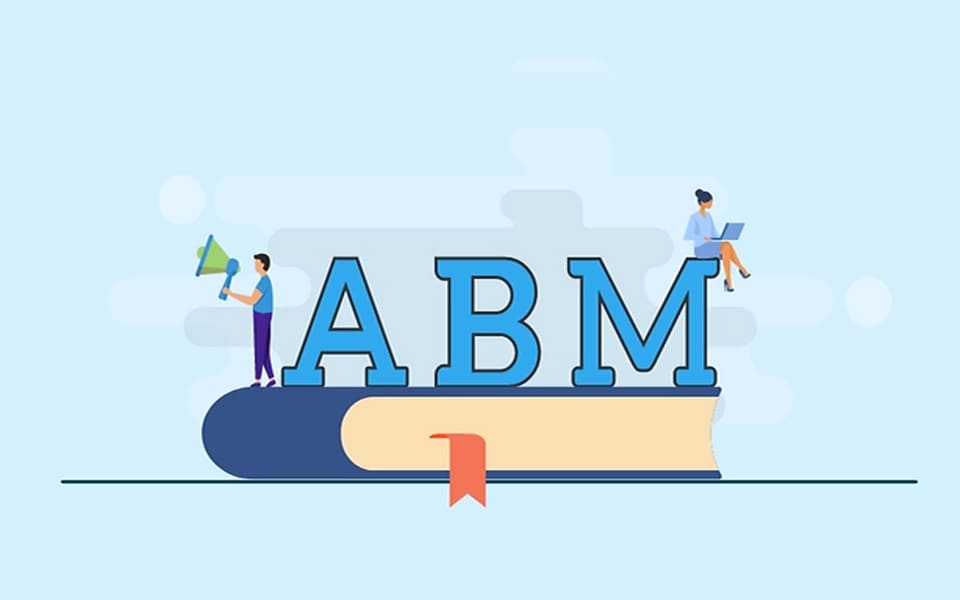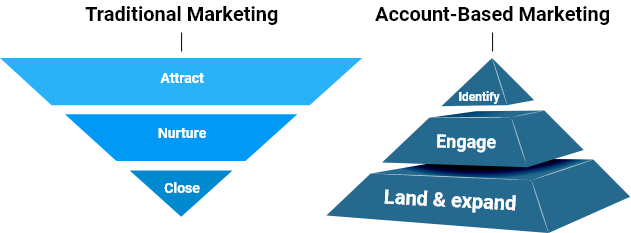Subscribe to Our Newsletter
Stay updated with the latest tips and strategies. Get additional discounts and alerts on offers.

The world of marketing is continuously changing with the evolution of new trends and mantras. Due to this constant shift, many salespeople find it tough to decide which trends to pay attention to. It is advisable to stick to the good old ones that have been here for decades.
One such marketing strategy is account-based marketing. It picks up speed as companies look to hone their marketing strategy to be more efficient and cost-effective.
In this blog, we have covered –
Account-based marketing, or ABM, also known as key account marketing, is a strategic business marketing approach based on customer awareness in which an organization considers and communicates with an individual prospect for higher returns.

Trish Bertuzzi, President and Chief Strategies, The Bridge Group, says – “With ABM, you are creating this strategic, orchestrated set of activities that makes you rise above the noise of what everyone else out there is doing and gets that account to say ‘Hey, I want to talk to you.’
Many B2B and B2C companies have always identified a handful of high-value accounts they think are most likely to convert and create individualized marketing campaigns across various channels. However, with the change in technology and digitization of marketing, ABM campaigns have become hyper-personalized, targeting prospects across multiple online platforms throughout their buying journey.
The success of any ABM campaign solely depends on the fact how well you know your leads. ABM replaces a mass-market approach to enable the sales teams to engage with the prospects and utilize the knowledge to provide need-based solutions to their pain points.
As mentioned below, the benefits of ABM, when done right, significantly outweigh the effort and lead to massive conversions and closed deals. In short, ABM is a messiah in disguise, which can save you time, money, and human resources.

The above points show that the account-based marketing tactic is a win-win situation. Marketers know who they’re reaching out to and can better personalize their tactic- maximizing marketing the impact, shortening the sales cycle, and laying the foundation for deeper relationships.
ABM also leads to better management of marketing resources, helps marketers and sales spend less time, money, and resources on campaigns, and focus on personalized campaigns designed to resonate with the most high-value prospects.
Traditional Marketing
Account-Based Marketing
To ensure your marketing campaigns generate the highest ROI, you must identify the accounts that present the most significant opportunity. We have listed six ways in which you can identify those critical accounts to target –
Building your Ideal Customer Profiles or ICPs is the best and most effective way to locate popular accounts. ICP is a description of the company that fits perfectly with your buyer. By creating a buyer profile, you will be able to gauge the pain points that need to be addressed and thus will be able to frame your ABM campaigns accordingly.
We posted a detailed guide on creating an ICP for lead generation in the B2B industry, along with downloadable templates. You can utilize them to build your customer profiles quickly.

Channel mapping is the process of identifying your most valuable channels and accounts and exploring what a company’s brand value means to a particular customer.
Channel mapping gives you a detailed overview of your audience and is an effective and critical step in defining your ABM strategy. With this information, you can focus your resources on your most valuable channels and partners.
Without the right data, your ABM tactics will not yield the desired results. With everything else right on the spot, sales must not neglect the quality of the CRM data. Important insights could be missing, which will lead to loss of leads and misuse of marketing funds. If you want to gain control over your sales pipeline data, polish your existing data.
We offer an array of data enrichment services that will ace up the quality of your contact and company database. Multiply your returns with a highly accurate, manually verified database right away!
Winning a customer is all about competition. Analyze your key customers’ accounts and take a look at the competitive brands they are looking at. You can then highlight the benefits of your solutions that these customers would miss out on in other brands. You can automate this process using tools like iDatalabs or HG Data, or do manual research using LinkedIn groups, review sites, and other online communities.
Now that you are creating your VIP clients’ list and have recognized them as high-yielding customers, let’s figure out how to strategize and design your ABM campaigns.
Extend your reach by connecting with key decision-makers.
Interact with your target accounts on a personal level across various channels. Here’s our guide to data-driven email marketing campaigns in 2021 for better lead nurturing and conversions.
Evaluate and optimize your ABM campaign using analytics tools.
If all these are too much for you to handle alone, you can seek a professional ABM service provider to launch successful campaigns. DataCaptive helps you align your sales and marketing teams to establish an effective ABM campaign. Not just that, we also provide you with contact details of your accounts and achieve resonating success in your marketing and sales campaigns. Avail of our rich database for all your account-based marketing needs. Target your high-value accounts and crack deals easily.
Tip – ABM in social media is impactful since you can be extremely targeted, personal, and conversational on those platforms. While social ads are usually part of ABM plans, the organic reach of social media must be a key part of your ABM strategy as well.
Before you dive into designing the ABM campaigns, there are essential steps that you need to consider. Here’s a simple ABM checklist that you need to decide on before you begin with account-based marketing.
Finalize how big or small do you want your ABM campaign to be. This determines the scope of everything else- budget, team, and technology/channels. The goal must be documented and communicated to all teams – sales, marketing, and leadership.
Budget plays a vital role in the execution of any marketing campaign. Research on how much funds you should allocate for ABM campaigns, and strategize it accordingly. There is no specific number to it. The best is to make sure that every dollar spent should drive the best possible impact.
Once your goal and budget are finalized, determine what type of team you need to execute the campaign. You can build an in-house team or outsource it to an ABM agency/specialist. Whatever method you choose, keep in mind that the sales goal is integrated into the team.
Ensure to make a list of your most important target accounts and get it agreed upon by all teams- marketing, sales, and leadership. Though this list can change over time, you’ll need a solidified prospect list to determine the starting point’s marketing channels.
Locate where the majority of your target accounts reside? Are they more active on LinkedIn, or in emails, or on Facebook? Depending upon their presence, train your team to choose the marketing channels and build a communication/content strategy for maximum response.
Based on the budget set and the content, you can decide if you want to manually carry out the ABM campaigns or take the help of an automated sales platform. It is advisable to go for an AI technology by integrating it into your sales and marketing funnel.
It would be best to optimize for visibility, engagement, sales acceleration, and other similar metrics. Depending upon your campaign goals, prioritize KPIs like organic traffic, on-site engagement, click rates, lead generation, sales numbers, and so on, which might be necessary for your business.
Agree upon metrics that reflect your main goals for the campaign. Measuring an ABM campaign’s response is the most crucial point to consider while designing an ABM checklist. You can use automation software or Google Analytics for this purpose.
Thomson Reuters is a leading news and information-based tools provider to professionals who used 9 ABM tactics.
Challenge – Drive customer retention, brand expansion, and streamline fast sales.
Solution –Targeted 500 accounts, divided them into three tiers, and implemented different ABM tactics for different tiers.
ABM Tactic 1: “Always on” Digital Marketing, including highly personalized programmatic ads.
ABM Tactic 2: Strategic field marketing inviting tier 3 accounts are requested in-market events strategically planned by the marketing team.
ABM Tactic 3: Content or event opportunity providing a chance to be quoted in a content piece or speak at an in-market event.
Uses the tier 3 tactics in addition to the ones below:
ABM Tactic 4: Door opener kits providing a dimensional mailer.
ABM Tactic 5: Trial incentives are giving access to the account for free for a limited period.
ABM Tactic 6: High–profile events are inviting the decision-makers to high-profile networking.
ABM Tactic 7: Dedicated a personnel account manager to program ads, customized to the company name, firmographics, and buying cycle stage.
ABM Tactic 8: Onsite product event where Thomson Reuters hosted online product demo events in the prospects’ offices. They also offer catered lunches, baristas, and more.
ABM Tactic 9: Executive-level thought leadership opportunities where the ABM team worked in partnership with the thought leadership group. This ensures that their top law customers have opportunities to speak at industry events and be published in blogs, white papers, and more.
Win rate: 95%
Shortening of the sales cycle: 72%
We are a professional B2B database service provider that provides innovative business solutions backed by intense market research and analysis. We aspire to empower businesses with our intent-based data solutions and help them achieve sustainable growth through profitable marketing and sales campaigns.
So far, we have enabled 70+ companies to identify, connect, nurture and convert their highly qualified prospects by enhancing their multi-channel campaigns and personalizing their lead engagement, customer acquisition, and retention processes.
Let us know your thoughts in the comment section below. Get in touch with us if you want us to write something for you.
Show Some Love!

Subscribe to Our Newsletter
Stay updated with the latest tips and strategies. Get additional discounts and alerts on offers.
Related Articles
Subscribe to Newsletter
Stay up to date with the latest marketing, sales, and service tips and news.
